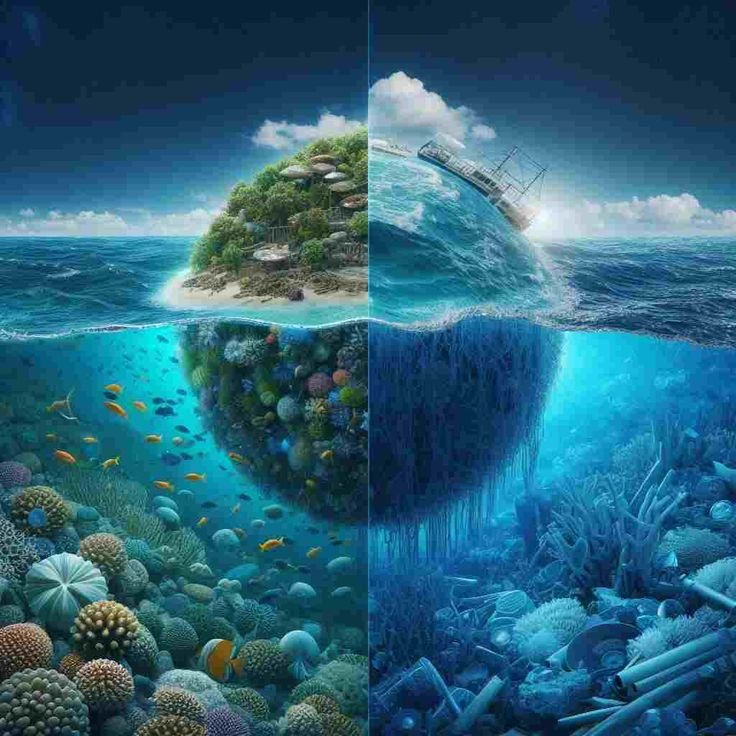Introduction: A Crisis Hidden in the Depths
Beneath the ocean’s glittering surface lies a crisis that few can see but one that affects every living thing on Earth. Ocean acidification — often called the other CO₂ problem — is silently altering the chemistry of our seas. As humans continue to burn fossil fuels, vast amounts of carbon dioxide (CO₂) are absorbed by the ocean, triggering chemical reactions that lower the water’s pH. The result is a more acidic ocean that threatens marine ecosystems, global food supplies, and the delicate balance that has supported life for millions of years.
The Chemistry of Acidification
The process of ocean acidification begins in the atmosphere. When CO₂ is released from burning coal, oil, and natural gas, about 30% of it is absorbed by the ocean. Once in the water, CO₂ reacts with seawater to form carbonic acid, which then breaks down into bicarbonate and hydrogen ions. The increase in hydrogen ions lowers the ocean’s pH, making it more acidic.
Before the Industrial Revolution, the average ocean pH was around 8.2. Today, it has dropped to about 8.1, representing a 30% increase in acidity. While this change might seem small, even a slight shift in pH has massive implications for marine life. The ocean’s chemistry is finely balanced, and acidification disrupts the very foundation of aquatic ecosystems.
The Victims of Acidification: Shell-Building Organisms
Among the first and most affected creatures are calcifying organisms, such as corals, oysters, clams, mussels, and certain types of plankton. These species rely on carbonate ions to build their shells and skeletons. However, as acidity increases, carbonate ions become less available, making it harder for them to grow or maintain their protective structures.
In coral reefs, acidification weakens the limestone skeletons that form their structure. This leads to slower growth rates and increased vulnerability to erosion. Similarly, shellfish industries around the world are experiencing mass die-offs of oyster larvae, particularly in the Pacific Northwest, where acidic waters corrode shells before they can fully form.
Coral Reefs in Peril
Coral reefs, often described as the rainforests of the sea, are among the ecosystems most at risk from ocean acidification. These vibrant habitats support about 25% of all marine species, providing shelter, food, and breeding grounds for countless fish and invertebrates.
Acidification not only slows coral growth but also intensifies coral bleaching, a stress response triggered by rising sea temperatures. When corals lose their symbiotic algae due to stress, they become pale, weak, and more susceptible to disease. With both warming and acidification on the rise, the world’s coral reefs face an existential threat. The Great Barrier Reef, for example, has suffered multiple mass-bleaching events in the past decade, with acidification further hindering its ability to recover.
Impacts on Marine Food Webs
Ocean acidification disrupts the base of the marine food chain. Tiny plankton species, such as pteropods (small sea snails), play a vital role as prey for fish, whales, and birds. When their shells dissolve in acidic waters, it affects the entire ecosystem.
As plankton populations decline, larger marine animals that rely on them — including salmon, cod, and even seabirds — face food shortages. In this way, acidification has a cascading effect, potentially altering entire food webs and threatening the livelihoods of millions who depend on fishing.
Fisheries and Human Livelihoods at Risk
The global seafood industry supports over three billion people who depend on fish as their main source of protein. Acidification endangers this food source. Shellfish farming, particularly oysters and mussels, has already suffered economic losses due to increasingly acidic coastal waters.
For small island nations and developing countries, this poses not only a food security crisis but also an economic one. Coral reefs, which protect shorelines from storms and attract tourists, are worth billions in annual revenue. As these ecosystems decline, local economies that rely on them begin to collapse, deepening global inequality and social challenges.
Ocean Acidification and Climate Change: A Dangerous Duo
Ocean acidification does not occur in isolation — it works hand in hand with global warming. As the ocean absorbs CO₂, it also absorbs heat, causing sea surface temperatures to rise. This dual stressor weakens marine organisms’ ability to adapt.
Additionally, warmer waters hold less oxygen, leading to “dead zones” where marine life struggles to survive. Combined, these forces create a hostile environment where once-thriving ecosystems are pushed toward collapse. The feedback loop is dangerous: as marine life declines, the ocean’s ability to absorb CO₂ decreases, accelerating climate change even further.
The Threat to Ocean Biodiversity
The ocean is home to more than 2 million species, many of which are still undiscovered. Acidification puts many of these at risk before scientists even have the chance to study them. From deep-sea corals to planktonic organisms, the loss of biodiversity threatens the stability and resilience of the marine environment.
Fish behavior is also changing. Research suggests that increased acidity can interfere with fish sensory systems, affecting their ability to detect predators, navigate, and communicate. This has serious implications for reproduction and survival rates, further altering oceanic ecosystems.
Regional Hotspots of Acidification
While acidification is a global problem, its effects are not evenly distributed. Certain areas — such as the Arctic, the North Pacific, and coastal upwelling zones — are experiencing faster chemical changes due to colder waters that absorb more CO₂.
In the Arctic, melting ice exposes more seawater to the atmosphere, speeding up absorption. In the Pacific Northwest, nutrient-rich waters brought to the surface through upwelling carry high levels of CO₂, intensifying acidification. These regional differences highlight the need for localized monitoring and adaptation strategies.
Monitoring and Research Efforts
Scientists are racing to understand the full extent of ocean acidification. Monitoring networks like the Global Ocean Acidification Observing Network (GOA-ON) collect vital data to track changes in pH and carbonate chemistry. Advanced sensors and satellite systems now allow for real-time monitoring across different regions, improving our understanding of how quickly the ocean is changing.
Marine biologists are also experimenting with adaptive aquaculture, breeding shellfish strains more resistant to acidic conditions. Meanwhile, researchers are studying how natural systems, such as seagrass meadows and mangroves, can help buffer acidity through photosynthesis.
Mitigation: Reducing CO₂ at the Source
The most effective way to combat ocean acidification is to reduce CO₂ emissions. Transitioning to renewable energy sources, enhancing energy efficiency, and protecting carbon sinks like forests and mangroves are essential steps. Global cooperation through agreements such as the Paris Climate Accord plays a critical role in slowing down further acidification.
On a smaller scale, restoring coastal habitats can make a measurable difference. Seagrass beds and mangrove forests absorb CO₂ and release oxygen, helping stabilize local marine environments. Reducing nutrient pollution and agricultural runoff also prevents further stress on coastal waters.
Adapting to a Changing Ocean
Communities dependent on the sea are learning to adapt. Fishermen are diversifying catches, shellfish farmers are adjusting breeding seasons, and coastal cities are investing in better water-quality monitoring. Education and awareness are equally vital — understanding the connection between everyday human actions and ocean health empowers people to make sustainable choices.
Technological innovations, such as artificial reefs and ocean alkalinity enhancement (adding crushed minerals to seawater to neutralize acidity), are being explored as potential long-term solutions. However, these are costly and complex, underscoring the need to address the problem at its root.
A Shared Responsibility
Ocean acidification is not just an environmental issue — it’s a human issue. Every breath we take and every meal we eat connects us to the ocean. Its decline affects our weather, our economies, and our survival. Protecting it requires global unity, scientific innovation, and a deep respect for nature’s balance.
As individuals, reducing carbon footprints, supporting sustainable seafood choices, and advocating for stronger environmental policies are ways to contribute. Collectively, humanity must recognize that the ocean’s health is directly tied to our own.
Conclusion: Listening to the Ocean’s Warning
The ocean has long been Earth’s life-support system — regulating climate, providing food, and sustaining biodiversity. But it is also sending us a warning. Ocean acidification is a silent yet powerful reminder of the consequences of human activity. If left unchecked, it will alter the planet’s chemistry, ecosystems, and the future of generations to come.
By acting now — reducing emissions, protecting marine habitats, and fostering global collaboration — we can preserve the balance of our blue planet. The ocean’s resilience depends on our willingness to change. The waves may be silent, but their message is clear: the time to act is now.


